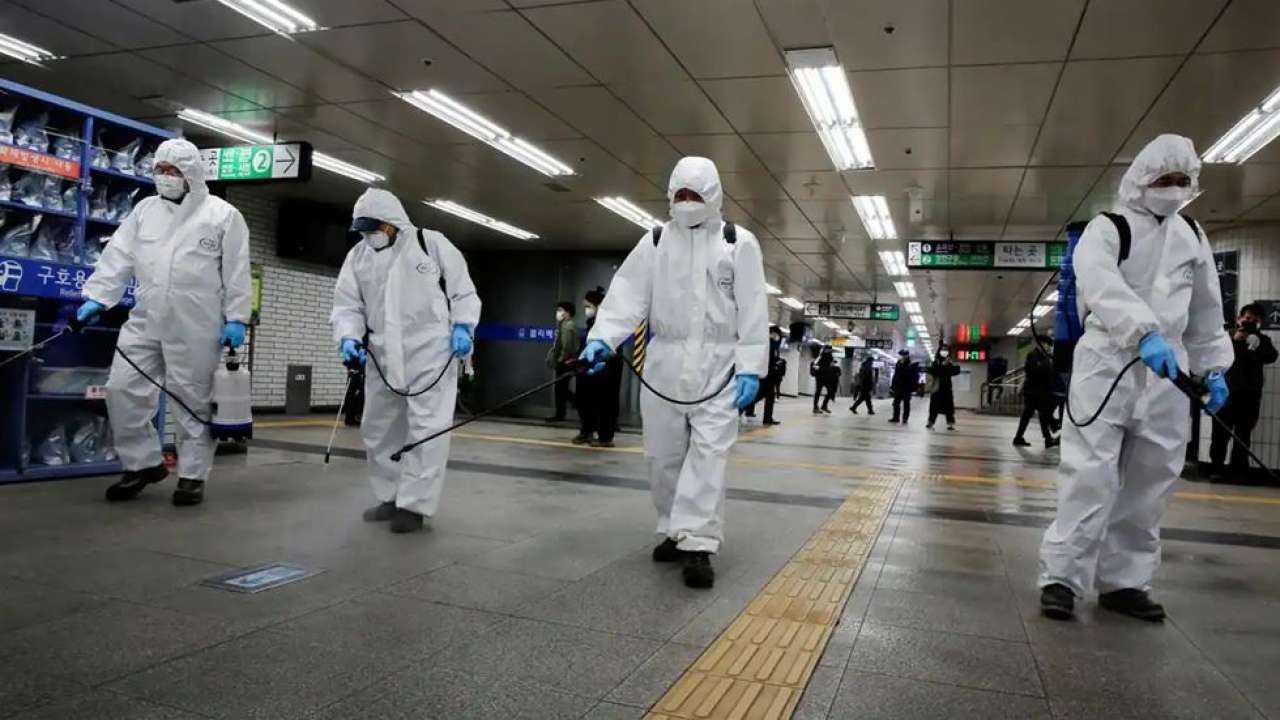| COVID-19 | |
| Sanitising desks between lessons: Is it really effective? by Anya Sithambaram '23 |  |
| A detailed discussion into the science of sanitisation
|
Anya Sithambaram '23 |
 |
I'm a person who is passionate about music, science, maths, computing, the environment... |
|
In the age of the pandemic, the school has been taking extra precautions to keep us safe. One of those precautions, of which we are all familiar with, is the sanitising of desks when we come into the classroom at the start of each lesson. The purpose of sanitising surfaces like desks and chairs is to “break the chain”, and prevent the transmission of the coronavirus. However, COVID-19 is primarily transmitted by inhaling virus-containing respiratory droplets - commonly known as “droplet transmission” when within 6 feet of an infectious person, or “airborne transmission” if the virus is suspended in the air for long periods of time before inhalation [1] - so why are we still sanitising? There has been suspected “contact transmission” of the coronavirus, due to the virus being shown to be able to survive on surfaces for a long time. Studies have shown that large amounts of coronavirus can remain on inanimate surfaces (also called “fomites”) for several days. The longest survival of severe acute respiratory syndrome coronavirus (SARS-CoV) on surfaces was shown in a study where there was still a detectable quantity of coronavirus on the tested surface after 6 days [2] . Another study showed how long the virus remained on a range of household materials, such as wood board, glass, metal and plastic. This study showed that remaining virus particles on metal, cloth, filter paper and in water were able to induce a typical cytopathic effect (due to the infection of the cell) on up to 25% of cells in a sample after 4 days [3]. However, firstly, these two studies investigated the SARS-CoV-1 virus that caused the 2002-2004 SARS outbreak, not the current SARS-CoV-2 virus that is causing COVID-19, and secondly, as pointed out in a Comment by Emanuel Goldman in The Lancet, these studies were done by placing very large initial titre samples of virus on the surfaces being tested: the first study placed 107 infectious viral particles, and the second study used 106 infectious viral particles (both determined as 50% tissue culture infectious doses (TCID50)) [4] As mentioned by Goldman, these studies have “little resemblance to real-life scenarios” and therefore the risk of catching COVID-19 by fomite transmission should not be assumed on the basis of these unrealistic scenarios. Another report showed the survival of coronavirus for up to 2 days on plastic and stainless steel, testing both SARS-CoV-1 and SARS-CoV-2, but using a similarly large sample of virus (105.25-7.00 TCID50 per millimeter) [5]. The closest to real-life circumstances was achieved by a study that swabbed surfaces in two hospitals during the 2003 SARS epidemic, and tested the samples for the SARS-CoV-1 virus by reverse-transcriptase polymerase chain reaction (RT-PCR) and viral culture [6]. Although 26 out of the 94 total swab samples had tested positive for viral RNA in the RT-PCR test, all swabs had cultures that showed no growth. This suggests that the detected RNA was from non-infectious genomes of the virus, which in turn indicates that those viruses would not have been able to infect a person who touched the surface. On the other hand, “It is also possible that there was viable virus on the surfaces but that it failed to grow after the initial handling, inconsistent refrigeration, or prolonged shipping time to the laboratories”, so perhaps it’s better to be safe than sorry, and to sanitise surfaces anyway - no harm in that right? But don’t forget, sanitisation doesn’t come without its own downfalls. There is considerable impact on the environment due to the amount of paper that we use every day to sanitise tables and chairs. Some may think that it’s alright because we can recycle the paper, but “reduce” comes before “recycle” in the famous “3 Rs” for a reason. Not only are trees cut down to produce paper, but the materials processing required to get from a tree to the paper that we use requires large amounts of energy, and releases waste products like harmful chemicals and greenhouse gases into the environment, causing pollution and other consequences like global warming. And what about the sanitising liquid? Assuming the sprays that we use in school contain ethanol as the alcohol used for disinfecting, ethanol doesn’t materialise out of thin air either. As we learn in IGCSE chemistry, ethanol can either be produced by the hydration of ethene, which is obtained from the catalytic cracking of crude oil (a non-renewable resource), or by the fermentation of glucose, and glucose has to come from somewhere (e.g. large potato farms that require the clearing of forests to plant) so that has its own ecological impacts too. But looking at it through another lens, you could argue that preventing the spread of disease and keeping people safe in a pandemic is far more important than worrying about cracking crude oil that would be cracked anyway or feeling sad about forests that have already been felled. Despite that, there are alternatives to ethanol for killing the coronavirus that should be considered, and one of them is already readily available to us in school: soap. In the context of handwashing, soap is very effective at killing the coronavirus, and it should be just as effective at disinfecting surfaces. It does this by essentially popping the outer layer of the coronavirus open, releasing its contents and killing the virus. So how exactly does it do that? Soap molecules have a hydrophilic (water-loving) head and a hydrophobic (water-hating) tail. When mixed with water, the soap molecules form ball-like structures called micelles, where the hydrophilic heads face out towards the water and the hydrophobic tails face inwards. This is because the hydrophobic tails like to seek out places where there is no water, so they bunch together. The outer layer of the coronavirus is made of phospholipids, which also have a hydrophilic head and a hydrophobic tail. They form a bilayer (double layer) around the virus with the heads facing out and tails facing towards each other. When confronted by a soap molecule, the hydrophobic tail of the soap molecule desperately tries to get to a place with no water, and wedges itself into the phospholipid bilayer that surrounds the virus, trying to get to the dry bit in the middle of the two layers. This breaks the coat of the virus, exposing the inner parts of the virus to the soapy water [7]. And that’s the end of the virus! But is soap really more effective than alcohol? A study found that alcohol-based handrubs had similar efficacy to non-antimicrobial soap (normal soap) and water against the virus MS2 bacteriophage after one “episode of hand hygiene”, but the handrubs showed significantly lower efficacy after many episodes [8]. Soap and alcohol work in a similar way against both SARS-CoV-2 and MS2 bacteriophage, and hand washing is not too different from table-wiping, so a similar efficacy would be expected if we were to apply this study to the disinfection of surfaces. Therefore, yes, soap and water is more effective in the long run. Furthermore, using alcohol-based disinfectants has another disadvantage. An increased use of alcohol against other pathogens like certain bacteria can cause them to develop resistance to the alcohol, which will cause problems as it will leave us with no way to kill the alcohol-resistant bacteria. Using soap reduces this problem because soap does not kill some types of bacteria anyway, so they will have no need to become resistant. Another plus for simple soap and water. All in all, although fomite transmission is low and the coronavirus doesn’t survive on surfaces for long, it’s still worth sanitising desks because new, sometimes contradictory research about SARS-CoV-2 comes out every day - we’re still learning about the virus after all. However, we could do with a change of tactic for sanitising, to try and reduce the environmental impact, and increase efficacy at the same time. I do acknowledge that using soap and water, and somehow doing away with using tissue paper and paper towels, present its own logistical challenges, but I think that we should at least be aware of the downfalls of what we are doing now, and the potential improvements we could make in the future. I’m not being pessimistic, but let’s face the facts: COVID-19 is not disappearing anytime soon, so we’ve got plenty of time to make changes. REFERENCES
[1] Scientific Brief: SARS-CoV-2 and Potential Airborne Transmission. Centers for Disease Control and Prevention. Updated October 5, 2020. Accessed February 28, 2021. https://www.cdc.gov/coronavirus/2019-ncov/more/scientific-brief-sars-cov-2.html |
LIKE 👍 COMMENT 💬 |
|
Leave a like or comment here! |